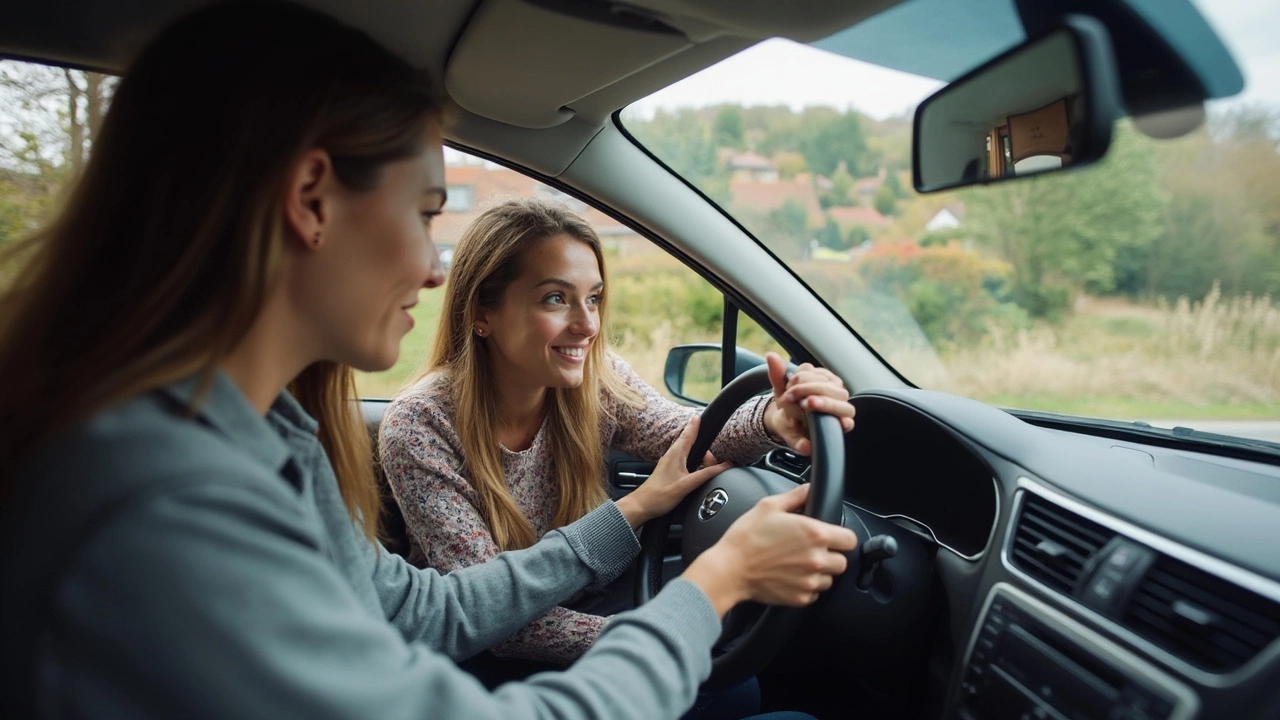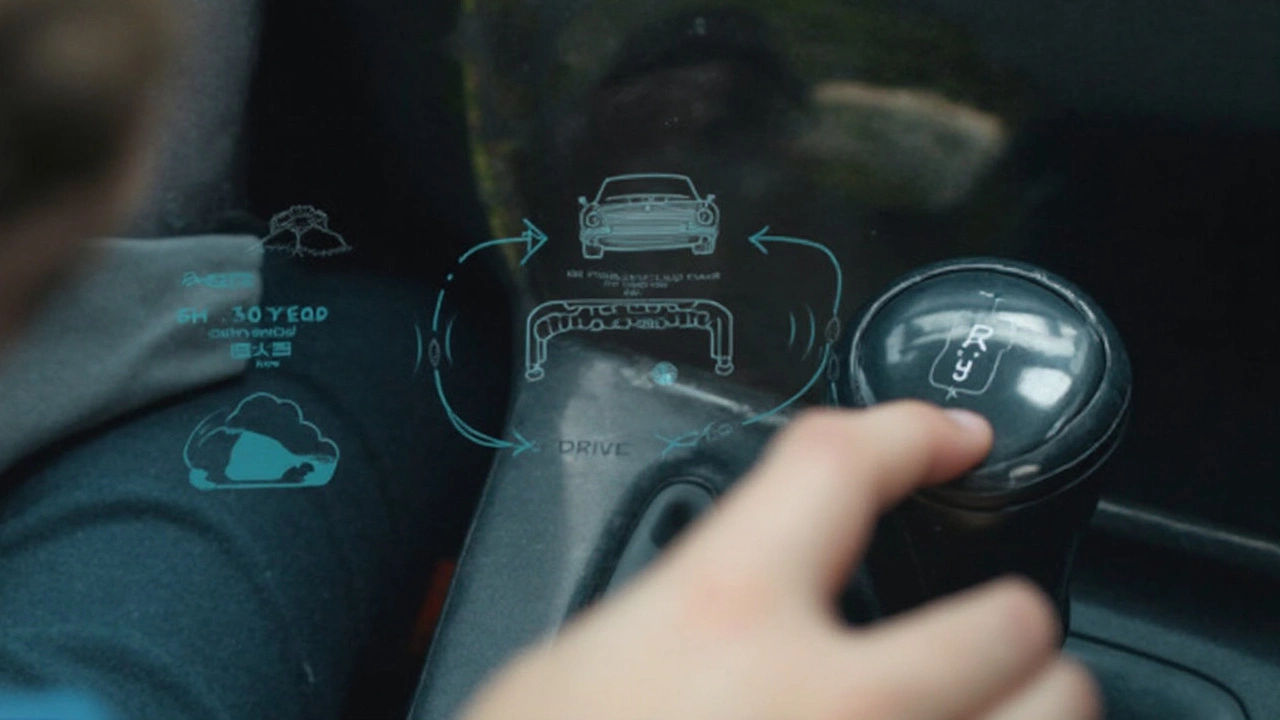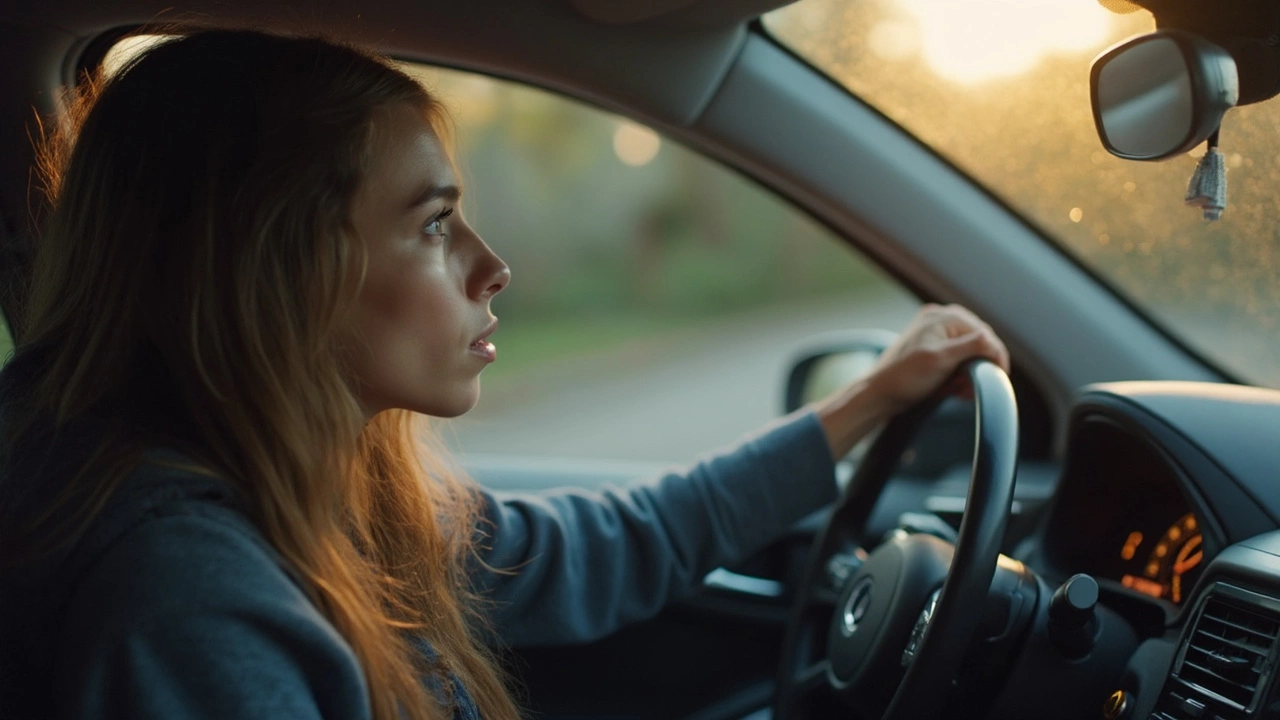Ever get behind the wheel of an automatic car and suddenly feel like there are too many buttons and lights? Take a breath—it’s much simpler than it looks. You don’t even need to touch a clutch or worry about stalling. The car does most of the heavy lifting for you.
The first thing you’ll notice is the gear shifter. No confusing H-patterns or guessing where things go. You’ll see simple options: P (Park), R (Reverse), N (Neutral), and D (Drive). Most people mess up because they skip right past these basics. Knowing what each one does saves you headaches down the line.
Before you start, keep your right foot ready. Your left foot? Let it chill, you won’t need it for driving in an automatic. This little fact actually helps improve safety—most new drivers who try to use their left foot end up pressing the brake too hard or hitting both pedals at once.
- Understanding Automatic Basics
- Step-by-Step Starting Process
- Common Issues Beginners Face
- Safety Tips Before You Drive
- Mistakes to Avoid and Smart Extras
Understanding Automatic Basics
If you’ve only heard of manual cars, an automatic can seem almost magical. But here’s the honest truth: automatic cars were built to make driving simpler. Instead of shifting gears yourself, the car does it for you. That means less to think about, especially when starting or stopping in traffic.
The main parts you need to know are the gear shifter, the pedals, and the ignition. Most automatic cars have two pedals: the accelerator and the brake. No clutch pedal at all. The gear shifter usually sits between the seats or sometimes to the right of the steering wheel. It’s got a lineup that looks like this:
- P (Park): For when you want the car to stay put. Always start and stop the car in this gear.
- R (Reverse): For backing up. Don’t use unless you’re stopped.
- N (Neutral): Loosens things up, so the engine isn’t connected to the wheels. Mainly used in car washes or if you have to push the car.
- D (Drive): For heading forward. Most of your time will be in here.
- S or L (Sport or Low): For slow speeds or going up/down steep hills. Not for regular driving.
The absolute must-know: automatic car safety features prevent big mistakes. For example, modern automatics won’t let you shift out of ‘P’ unless your foot’s on the brake. This helps stop the car from rolling away when you start.
To clear up a common mix-up, here’s a quick comparison of the pedals and shifter in manual and automatic cars:
| Manual Car | Automatic Car | |
|---|---|---|
| Number of Pedals | 3 (Clutch, Brake, Gas) | 2 (Brake, Gas) |
| Gear Shifter | Multiple gears, clutch needed | P, R, N, D. No clutch |
Another cool fact: most new cars worldwide are now automatics. In 2024, around 96% of cars sold in the US had automatic transmissions. That’s proof people value convenience and ease of use.
Remember, you drive with your right foot only. Your left foot gets to take a vacation. Keep this in mind and you’re already ahead of most beginners.
Step-by-Step Starting Process
Alright, let’s get right into it. Starting an automatic car is way less nerve-racking than some folks think. Just follow these steps, and you’ll be rolling without fuss. Here’s how to do it, the right way:
- Check That You're In Park (P): Before you touch anything, look at the gear shifter. The car needs to be in “P” for Park. You can’t start most automatics in any other gear—there’s a special safety feature wired in.
- Foot on the Brake: Place your right foot gently on the brake pedal. You’ll notice most cars won’t even crank unless your foot is pressing the brake—another safety thing car makers put in.
- Start the Engine: Now turn the key or push the start button (in newer models). Keep your foot on the brake. The engine should come alive. In most recent cars (2012 and after), there’s a dashboard light-up check just before the engine kicks in.
- Check Your Dashboard: Give your dashboard a quick look. If warning lights stay on after a few seconds, don’t ignore them—something might need checking. A little known fact: almost half of new drivers ignore the check engine or oil light during their first year and end up with breakdowns that could have been avoided.
- Shift to Drive (D) or Reverse (R): With your foot still on the brake, move the gear selector to D if you’re heading forward, or R if you’re backing out. Do this slowly—not yanking the lever back and forth—because abuse can wear out the transmission faster than you’d expect.
- Double-check Around: Before moving, look around. Check mirrors, glance over your shoulder. There’s data showing new drivers who check their blind spots reduce their chances of minor accidents by 30%.
- Ease Off the Brake: Take your foot off the brake gently. The car will start to creep forward (or backward) on its own without even touching the gas pedal. That’s called ‘creeping’—it’s totally normal in automatics and can be handy for parking.
Here’s a quick cheat sheet for starting an automatic the right way:
| Step | Why It Matters |
|---|---|
| Gear in Park (P) | Essential for safety, car won’t start otherwise |
| Foot on Brake | Prevents the car from moving unexpectedly |
| Start Engine | All systems check and ready to drive |
| Check Dashboard | Catch problems before moving |
| Shift to D/R | Prepares for actual movement |
| Check Around | Reduces risk of accidents |
| Release Brake | Controls your movement safely |
Following this order makes the first-time start smooth, hassle-free, and safe. Don’t skip a step—each one is there for a reason.

Common Issues Beginners Face
You’d be surprised how many people run into the same problems when they first sit in an automatic car. It’s normal to feel awkward or second-guess what you’re supposed to do. Most mistakes aren’t dangerous, but knowing them ahead of time can save you embarrassment and help you learn faster.
- Trying to start the car in Drive (D) or Reverse (R): Many beginners forget the car must be in Park (P) or sometimes Neutral (N) to start. Most new automatics actually stop you from starting in the wrong gear, but older cars might not.
- Pressing both pedals by accident: People who drive manuals often try using both feet. In an automatic, just use your right foot. Using both can make the car jerk or even trigger a warning light.
- Confusing the pedals: It’s common to hit the gas instead of the brake, or vice versa, especially during stressful situations. Get familiar with which pedal is which before you start driving.
- Forgetting to put your foot on the brake: Modern automatic cars usually need you to hold the brake pedal down before starting or shifting out of Park. Skipping this step means the car won’t move.
- Not releasing the handbrake (parking brake): Leaving it on can make the car lurch or stall when you press the accelerator. Always make sure it’s fully down before you start driving.
There’s actually some interesting data about beginner mistakes in automatics. According to a small study by the UK’s DVSA, new drivers in automatic cars most often fumbled with gear selection and pedals in their first few lessons.
| Mistake | Percentage of Beginners (UK DVSA Study 2022) |
|---|---|
| Wrong Gear Selection | 38% |
| Confusing Pedals | 29% |
| Handbrake Left On | 18% |
| Forgetting Brake to Start | 15% |
Don’t beat yourself up if you make these mistakes. Most people get the hang of it by their third or fourth go. Just slow down, go through the steps in your head, and keep practicing. The more comfortable you get, the smoother everything becomes.
Safety Tips Before You Drive
Before you even turn the key or press the start button, making sure you and your passengers are safe comes first. It sounds basic, but skipping these steps is where a lot of beginners mess up—sometimes with serious results. Over 60% of new drivers admit to rushing and overlooking safety checks, which can lead to simple but avoidable accidents.
- Always check that your seat and mirrors are adjusted. Sit so you can reach the pedals easily—your knees should bend a bit, not lock tight. You want a good view all around, especially through your side mirrors and rearview mirror.
- Don’t forget the seatbelt. Cars now often beep at you if it’s not clicked, but get in the habit of doing it right away, for everyone in the car.
- Before starting your automatic car, make sure your foot is firmly on the brake pedal. The car won’t start or shift out of Park without this step in most modern vehicles.
- Look around for anything you might hit—kids’ bikes, pets, or even something like a rolling trash bin. Just one quick walk-around can catch stuff you’d miss from the driver’s seat.
- Double-check the dashboard for warning lights. If something’s flashing or looks off, stop and figure it out. Ignoring a warning light is one of the main reasons cars end up stalled or break down during practice runs.
It can be helpful to have a mini checklist, especially when learning. Here’s what a quick pre-drive check might look like according to recent UK driving school guidelines:
| Item | What to Check |
|---|---|
| Seat/Mirrors | Proper adjustment for posture and visibility |
| Seatbelt | All belts clicked in place |
| Foot on Brake | Firmly press before starting |
| Surroundings | Clear from obstacles, pets, or toys |
| Dashboard Lights | No warning lights showing |
Taking sixty seconds to run through these points saves a ton of hassle. Plus, showing this habit in your driving lesson is a major bonus; instructors love it when you treat safety as a priority from the start.

Mistakes to Avoid and Smart Extras
It’s super common for beginners to make a few blunders when learning to drive an automatic car. Most of these boil down to just not knowing the basics or getting nervous. Here’s what you should actually watch out for:
- Starting in the wrong gear: Don’t try to start the engine when the gear is in D (Drive) or R (Reverse). Modern automatics usually refuse to start unless you’re in P (Park), but older models might roll if you get this wrong.
- Pressing both pedals: Only use your right foot for both brake and gas. Using your left foot can lead to slamming the brake by accident and makes your driving less smooth.
- Not holding the brake when shifting from Park: The car can lurch forward or backward unexpectedly, which is nerve-wracking and dangerous, especially in parking lots.
- Forgetting to fully stop before shifting: Switching from D to R or vice versa should only happen when you’re completely stopped. If you skip this, you can mess up the transmission—repairs can run thousands of dollars.
- Ignoring dashboard warning lights: Some newbies just power through when something flashes on the dash. Don’t. Pay attention to those signs. They’re there for a reason, and ignoring them could leave you stranded.
On the brighter side, here are a few smart extras that make your experience better:
- Auto-hold/creep features: A lot of automatics automatically inch forward when you release the brake in Drive. This helps in traffic or when parking. Some have an auto-hold button that keeps the brakes on, so you can relax at red lights.
- Engine stop-start systems: Modern cars sometimes turn off the engine at stops to save fuel and cut down on pollution. The engine pops back on when you release the brake. If your car has this, get used to it so you don’t panic the first time it goes quiet.
- Electronic parking brakes: Instead of pulling a handbrake, you might just push a button. If you park on a hill, make sure this is engaged before turning off the car.
Take a look at some stats on common beginner mistakes in automatics:
| Mistake | Reported by New Drivers (%) |
|---|---|
| Using both feet on pedals | 49% |
| Forgetting to fully stop before shifting | 33% |
| Not checking gear before starting | 28% |
If you keep these mistakes and extras in mind, you’ll have a much smoother start in your automatic car. Practice makes perfect, so don’t stress about not getting it right on your first go.

